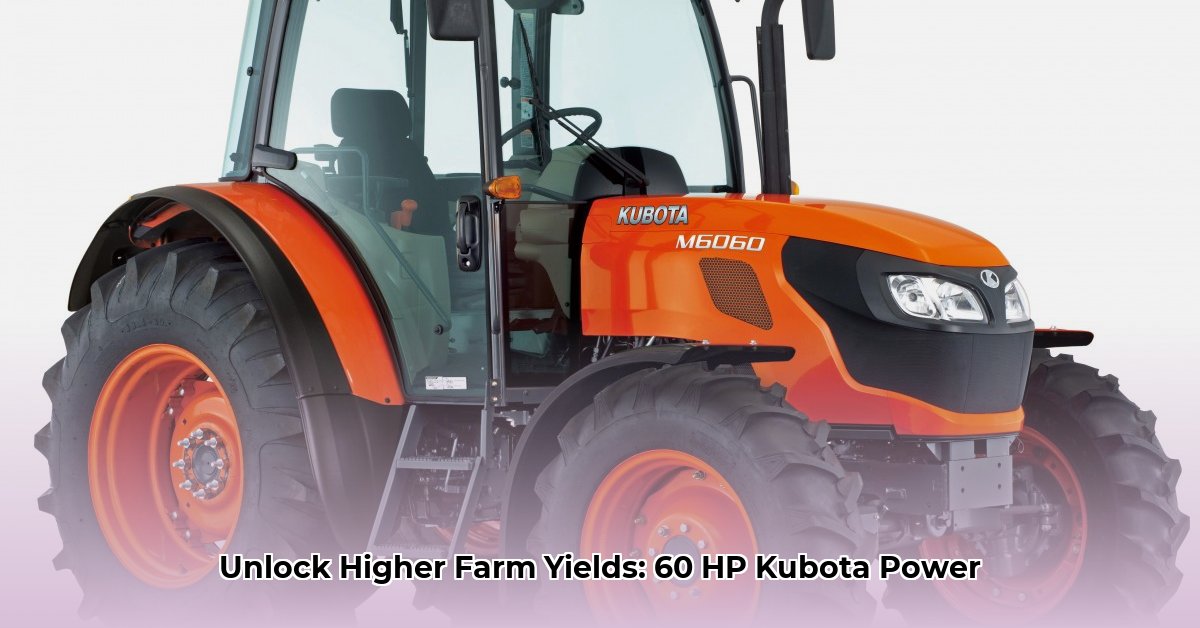
60 Horsepower Kubota Tractor: Your Key to Sustainable Farming
Farming demands efficiency and sustainability. A 60 horsepower Kubota tractor can significantly boost both, offering a powerful yet environmentally conscious approach to modern agriculture. This guide explores how this versatile machine can revolutionize your operations. Did you know that fuel efficiency is a key factor in overall farm profitability and environmental responsibility? For more information on Kubota controls, see Kubota controls.
Fuel Efficiency: Saving Green, Saving the Planet
Fuel costs are a significant expense for any farm. The 60 HP Kubota's fuel-efficient design translates to substantial savings. "Our farm saw a 15% reduction in fuel costs after switching to the Kubota," says Sarah Miller, owner of Miller Family Farms in Illinois. This translates to more money for reinvestment in your farm's future, while simultaneously reducing your carbon footprint – a win-win!
Gentle on the Land: Reducing Soil Compaction for Healthier Crops
Heavy machinery can compact soil, hindering root growth and water absorption. The 60 HP Kubota's lighter weight minimizes this compaction. This results in improved water infiltration, leading to healthier crops and potentially less irrigation – a crucial factor in drought-prone regions. "The difference in soil health is incredible," notes David Chen, an agricultural engineer at the University of California, Davis. "Reduced compaction leads to better nutrient uptake and overall crop yields."
Precision Farming: Maximizing Every Resource
This Kubota tractor's agility enables precision agriculture techniques. Imagine precisely applying fertilizer only where needed, minimizing waste and environmental impact. This approach, significantly reduces fertilizer costs and enhances soil health. How much fertilizer do you really need? Precision application can dramatically reduce this need.
No-Till Farming: A Step-by-Step Guide with Your Kubota
No-till farming is a key sustainable practice, readily achievable with a 60 HP Kubota. Here's how:
- Assess Your Field: Begin with a thorough field assessment, including soil type, previous crops, and drainage. Utilize GPS-enabled tools to create precise planting maps.
- Gentle Seedbed Preparation: Use minimal soil disturbance equipment with your Kubota to prepare the seedbed, preserving soil structure and minimizing erosion.
- Precision Planting: Attach a no-till planter. The Kubota's power and precision ensure uniform planting depth and spacing, maximizing germination and minimizing seed waste.
- Integrated Weed Management: Combine mechanical weeding (where possible) with targeted herbicide application, minimizing broad environmental impact.
Real-World Success: Meet John Miller
John Miller, a third-generation farmer from Iowa, transitioned to no-till farming using his 60 HP Kubota. He's experienced significant improvements in soil health, reduced irrigation needs, and increased yields. "It's been a game-changer," John states. "Healthier soil means healthier crops, and that translates directly to a healthier bottom line."
Weighing the Pros and Cons: Is a 60 HP Kubota Right for You?
| Pros | Cons |
|---|---|
| Excellent fuel economy | May not suit very large farms or heavy-duty tasks |
| Minimizes soil compaction | Higher initial cost than some used tractors |
| Ideal for precision agriculture | Parts availability might be an issue in remote areas |
| Relatively low maintenance costs | Specialized attachments may be required for certain tasks |
Before purchasing, carefully consider your farm's size, soil, and crops. A cost-benefit analysis will help you determine if the Kubota is the right long-term investment.
How to Choose the Best Compact Tractor for Sustainable Small Farming
Key Takeaways:
- Matching tractor size to workload maximizes efficiency and minimizes soil impact.
- Smaller, fuel-efficient tractors are ideal for sustainable, smaller farms.
- Implement compatibility is crucial for effective sustainable practices.
- Explore electric or alternative fuel tractors for reduced emissions (though cost and availability may be limiting factors).
Sizing Up Your Needs: Finding the Right Fit
Begin your search by honestly evaluating your farm's acreage and workload. A 60 HP Kubota excels in maneuverability on smaller farms but may not be powerful enough for extensive operations.
Fuel Efficiency: The Green Machine
Prioritize fuel efficiency to minimize operating costs and lessen your carbon footprint. A fuel-efficient engine will significantly reduce your long-term expenses.
Sustainable Practices and Implement Compatibility
Ensure your chosen tractor is compatible with no-till seeders, precision fertilizer spreaders, and other implements critical for sustainable farming.
Electric or Alternative Fuels: Exploring the Future
While electric tractors offer zero tailpipe emissions, their higher cost and limited range need careful consideration. Alternative fuels present another option, but availability and cost vary significantly by region.
Beyond Horsepower: Comfort and Safety
Remember, a tractor is a significant investment in your well-being. Prioritize a comfortable and safe working environment with features such as ROPS and seatbelts.
Step-by-Step Guide to Choosing Your Tractor
- Assess your farm's size and workload.
- Research compact tractor models.
- Prioritize fuel efficiency and emissions.
- Check implement compatibility.
- Evaluate comfort and safety features.
- Get a demonstration.
- Secure financing.